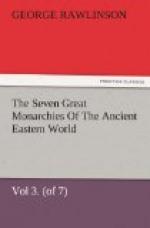That artabe and angarus were Persian words no less than Median, we have the evidence of Herodotus. Artades, “just men” (according to Hesychhis), is probably akin to ars, “true, just,” and may represent the ars-data, “made just,” of the Zendavesta. Devas (Seven), which Hesychius translates “the evil gods” is clearly the Zendic daiva, Mod. Pers. div. (Sans, deva, Lat. divus). In candys we have most probably a formation from qan, “to dress, to adorn.” Spaka is the Zendic cpa, with the Scythic guttural suffix, of which the Medes were so fond, cpa itself being akin to the Sanscrit cvan, and so to hvoov and canis. Thus we may connect all the few words which are known as Median with forms contained in the Zend, which was either the mother or the elder sister of the ancient Persian.
That the Medes were acquainted with the art of writing, and practised it—at least from the time that they succeeded to the dominion of the Assyrians—scarcely admits of a doubt. An illiterate nation, which conquers one in possession of a literature, however it may despise learning and look down upon the mere literary life, is almost sure to adopt writing to some extent on account of its practical utility. It is true the Medes have left us no written monuments; and we may fairly conclude from that fact that they used writing sparingly; but besides the antecedent probability, there is respectable evidence that letters were known to them, and that, at any rate, their upper classes could both read and write their native tongue. The story of the letter sent by Harpagus the Mede to Cyrus in the belly of a hare, though probably apocryphal, is important as showing the belief of Herodotus on the subject. The still more doubtful story of a despatch written on parchment by a Median king, Artseus, and sent to Nanarus, a provincial governor, related by Nicolas of Damascus, has a value, as indicating that writer’s conviction that the Median monarchs habitually conveyed their commands to their subordinates in a written form. With these statements of profane writers agree certain notices which we find in Scripture. Darius the Mode, shortly after the destruction of the Median empire, “signs” a decree, which his chief nobles have presented to him in writing. He also himself “writes” another decree addressed to his subjects generally. In later times we find that there existed at the Persian court a “book of the chronicles of the kings of Media and Persia,” in which was probably a work begun under the Median and continued under the Persian sovereigns.
If then writing was practised by the Medes, it becomes interesting to consider whence they obtained their knowledge of it, and what was the system which they employed. Did they bring an alphabet with them from the far East, or did they derive their first knowledge of letters from the nations with whom they came into contact after their great migration? In the latter case, did they adopt, with or without




